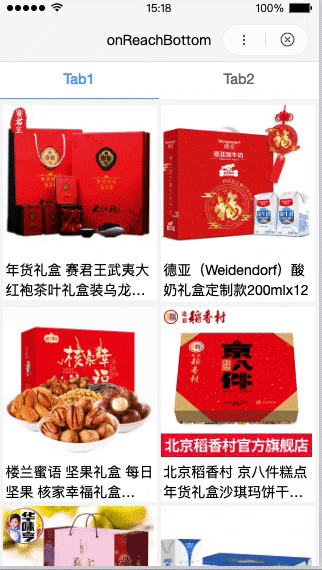小程序开发中四种方式快速实现上拉触底加载效果
发表时间:2021-1-6
发布人:葵宇科技
浏览次数:85
在智能小程序的开发过程中,上拉加载是一种十分常见的加载效果,最近也收到了一些开发者在开发上拉加载时遇到的问题,今天的内容就为您介绍一下如果想实现下述效果的上拉加载,我们需要如何去做。

以下是为大家总结的四种常见的实现方式:
- 使用 onReachBottom 实现
- 使用 scroll-view 组件实现
- 使用信息流模板实现上拉加载
- 使用 swiper 组件配合 onReachBottom 实现上拉加载
使用 onReachBottom 实现
智能小程序提供了onReachBottom,即页面上拉触底事件的处理函数。可以拿在 Page 中定义 onReachBottom 处理函数,监听该页面用户上拉触底事件,从而实现上拉加载。
为方便大家直接使用看到效果,将下述代码片段,直接导入开发者工具中运行查看即可:swanide://fragment/7e944c0c3785bbdf4437c672dd0dc8e41584413934361
代码解析
-
swan 文件是每个智能小程序页面的展现模板,类似于 Web 开发中的 HTML,所以我们先在 swan 文件中设置商品的展现样式:
<view class="goodsList"> <block s-for="item,index in goods"> <view class="goodsItem"> <view class="goodsImage"> <image src="{{item.img}}"></image> </view> <view class="goodsTitle"> <text>{{item.title}}</text> </view> </view> </block> </view> <view class="loading">努力加载中...</view> -
在 js 文件中使用
onReachBottom事件,当页面滑动到页面底部时,请求下一页展示数据,即实现上拉加载的效果。... ... onReachBottom() { //触底时继续请求下一页展示的数据 this.initData(); }
使用 scroll-view 组件实现
利用 scroll-view 组件实现上拉加载也是一种十分常见的方法,实现步骤与使用onReachBottom事件类似。
scroll-view是百度智能小程序提供的组件,可实现试图区域的横向滚动和竖向滚动。使用它的bindscrolltolower属性,当页面滚动到底部或右边的时候,则会触发scrolltolower事件,从而实现上拉加载的效果。
为方便大家直接使用看到效果,将下述代码片段,直接导入开发者工具中运行查看即可:swanide://fragment/fccd71b098a7d3921b9958ccd9dba1071584414516291
代码解析
在 swan 文件中使用 scroll-view 组件,设置商品的展现样式。当页面滑动至底部时,触发scrolltolower事件,实现试图区域的竖向滚动。
<view class="intro">
<scroll-view
class="scrollview"
scroll-y
bindscrolltolower="scrolltolower"
>
<view class="goodsList">
<view s-for="item,index in goods">
<view class="goodsItem">
<view class="goodsImage">
<image src="{{item.img}}"></image>
</view>
<view class="goodsTitle">
<text>{{item.title}}</text>
</view>
</view>
</view>
</view>
<view class="loading">努力加载中...</view>
</scroll-view>
</view>使用信息流模板实现上拉加载
信息流模版是百度智能小程序提供的组件,可配置上拉刷新、列表加载、上拉加载功能,适用于列表信息展示,并可放置在页面的任何部分。
与其它组件功能不同,使用信息流模板时需执行下述命令行,引入页面模板。
npm i @smt-ui-template/page-feed并在进入page-feed文件夹后,执行下述命令行安装所有模板依赖。
npm i 为方便大家直接使用看到效果,将下述代码片段,直接导入开发者工具中运行查看即可:swanide://fragment/71af2b7f470b29b13f792c417fc5f03c1588757790402
代码解析
- 在 swan 文件中使用信息流模板,通过 smt-spin 组件加载更多数据。
<smt-feed
class="smt-feed pull-down-refresh"
pull-to-refresh
bind:scrolltolower="scrollToLower"
text="{{text}}"
style="height: 100vh" <!-- 信息流组件作为局部滚动组件,必须在它的父级或本身指定高度 -->
>
<view class="goodsList">
<view s-for="item,index in goods">
<view class="goodsItem">
<view class="goodsImage">
<image src="{{item.img}}"></image>
</view>
<view class="goodsTitle">
<text>{{item.title}}</text>
</view>
</view>
</view>
</view>
<smt-spin status="{{status}}" bind:tap="reload"></smt-spin>
</smt-feed>- 在js文件中,利用在smt-spin组件上绑定的事件,实现加载更多的数据。
...
...
async scrollToLower() {
const goods = await this.initData();
await syncSetData(this, {
goods: goods.concat(this.data.goods || [])
});
},
...
...使用 swiper 组件配合 onReachBottom 实现上拉加载
使用 swiper 组件配合 onReachBottom 的实现方法也比较常见,相较上边两种实现方式有些复杂,但同时也可以实现更加复杂的上拉加载场景。
swiper 组件是智能小程序提供的滑块视图组件,与 swiper-item 组件配合使用,可实现 swiper 组件内 swiper-item 的滑动。需要动态设置 swiper 组件的高度,来保证每次滑动到底时都能触发 onReachBottom 。
为方便大家直接使用看到效果,将下述代码片段,直接导入开发者工具中运行查看即可:swanide://fragment/20e8fd8c561418df7c4f24a850bf43461585224391100
代码解析
-
根据实际场景需要在 swan 文件中设置 tab,当设置多个tab时,实现效果如下:
<view class="swiper-tab"> <view class="tab-item {{currentTab==0 ? 'on' : ''}}" data-current="0" bindtap="swiperNav">Tab1</view> <view class="tab-item {{currentTab==1 ? 'on' : ''}}" data-current="1" bindtap="swiperNav">Tab2</view> </view> - 在 swan 文件中使用 swiper、swiper-item 组件。
<swiper class="swiper" style="height: {{swiperH}}" current="{{currentTab}}" bindchange="swiperChange">
<swiper-item class="item">
<view class="goodsList">
<view s-for="item,index in goods">
<view class="goodsItem">
<view class="goodsImage">
<image bindload="imageLoad" src="{{item.img}}"></image>
</view>
<view class="goodsTitle">
<text>{{item.title}}</text>
</view>
</view>
</view>
</view>
<view class="loading">努力加载中...</view>
</swiper-item>
<swiper-item class="item">
<view class="goodsList">
<view s-for="item,index in goods">
<view class="goodsItem">
<view class="goodsImage">
<image src="{{item.img}}"></image>
</view>
<view class="goodsTitle">
<text>{{item.title}}</text>
</view>
</view>
</view>
</view>
<view class="loading">努力加载中...</view>
</swiper-item>
</swiper>- 在 js 文件中设置 swiper 组件的高度。
// 给image添加load事件,保证图片全部加载出来再计算swiper-item的高度并赋值给swiper
imageLoad() {
let len = this.data.goods.length;
this.setData({
imgLoadNum: ++ this.data.imgLoadNum
})
if(this.data.imgLoadNum === len){
this.queryNodeInfo();
}
},
// 设置swiper的高度,如果不动态设置swiper的高度,当页面滑动到底部时,不会触发onReachBottom
queryNodeInfo: function(){
let currentTab = this.data.currentTab;
swan.createSelectorQuery().selectAll('.item').boundingClientRect((rect) => {
this.setData({
swiperH: rect[currentTab].height + 'px'
})
}).exec();
}- 在 js 文件中使用
onReachBottom事件,当页面滑动到页面底部时,请求下一页展示数据,即实现上拉加载的效果。
onReachBottom() {
this.initData();
},总结
使用方法 1、2、3 可快速实现简单页面的上拉加载;而使用方法 4 可实现页面中存在多个 tab 的场景,比如:最新、最热列表的切换。开发者可根据实际情况选择不同的实现方法。
文章转载自:segmentfault 作者:小花









